Application of Nursing Theories: Orem's Self-Care and Johnson's Model
VerifiedAdded on 2023/06/03
|7
|1304
|348
Essay
AI Summary
This essay provides an analysis of two prominent nursing theories: Dorothy Orem's Self-Care Theory and Dorothy Johnson's Behavioral System Model. It explores how Orem's grand theory, focusing on self-care activities and the nurse's role in addressing self-care deficits, can be applied in patient settings, particularly in identifying patient needs and developing targeted interventions. The essay also examines Johnson's middle-range theory, which views nursing as an external regulatory force for maintaining patient equilibrium, emphasizing assessment, diagnosis, planning, implementation, and evaluation. The application of Johnson's theory is illustrated through designing nursing care programs, highlighting the importance of a systems approach and the development of therapeutic relationships. The essay concludes that both theories offer valuable frameworks for nursing practice, guiding practitioners in systematically addressing patient needs and improving clinical outcomes. Desklib offers more such solved assignments for students.
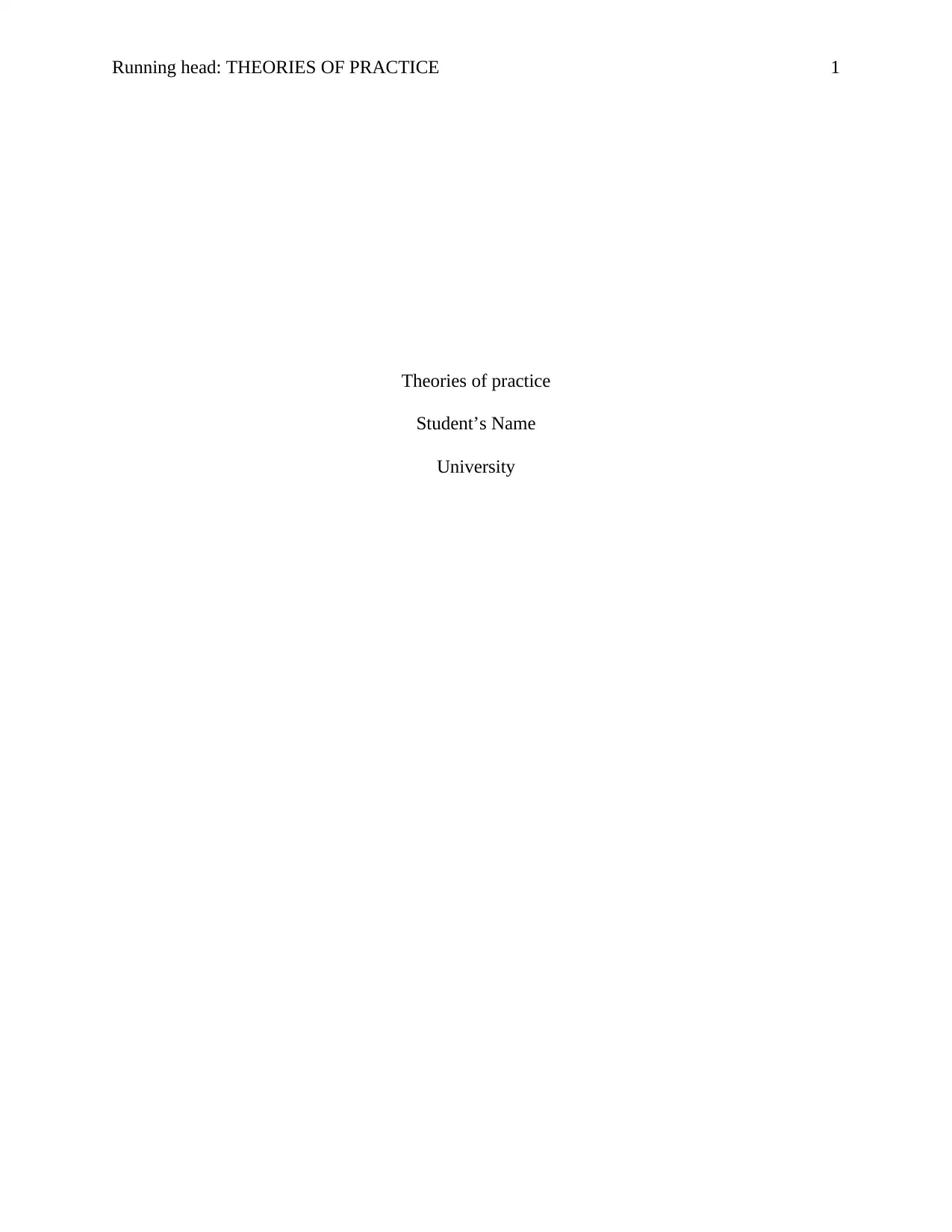
Running head: THEORIES OF PRACTICE 1
Theories of practice
Student’s Name
University
Theories of practice
Student’s Name
University
Paraphrase This Document
Need a fresh take? Get an instant paraphrase of this document with our AI Paraphraser
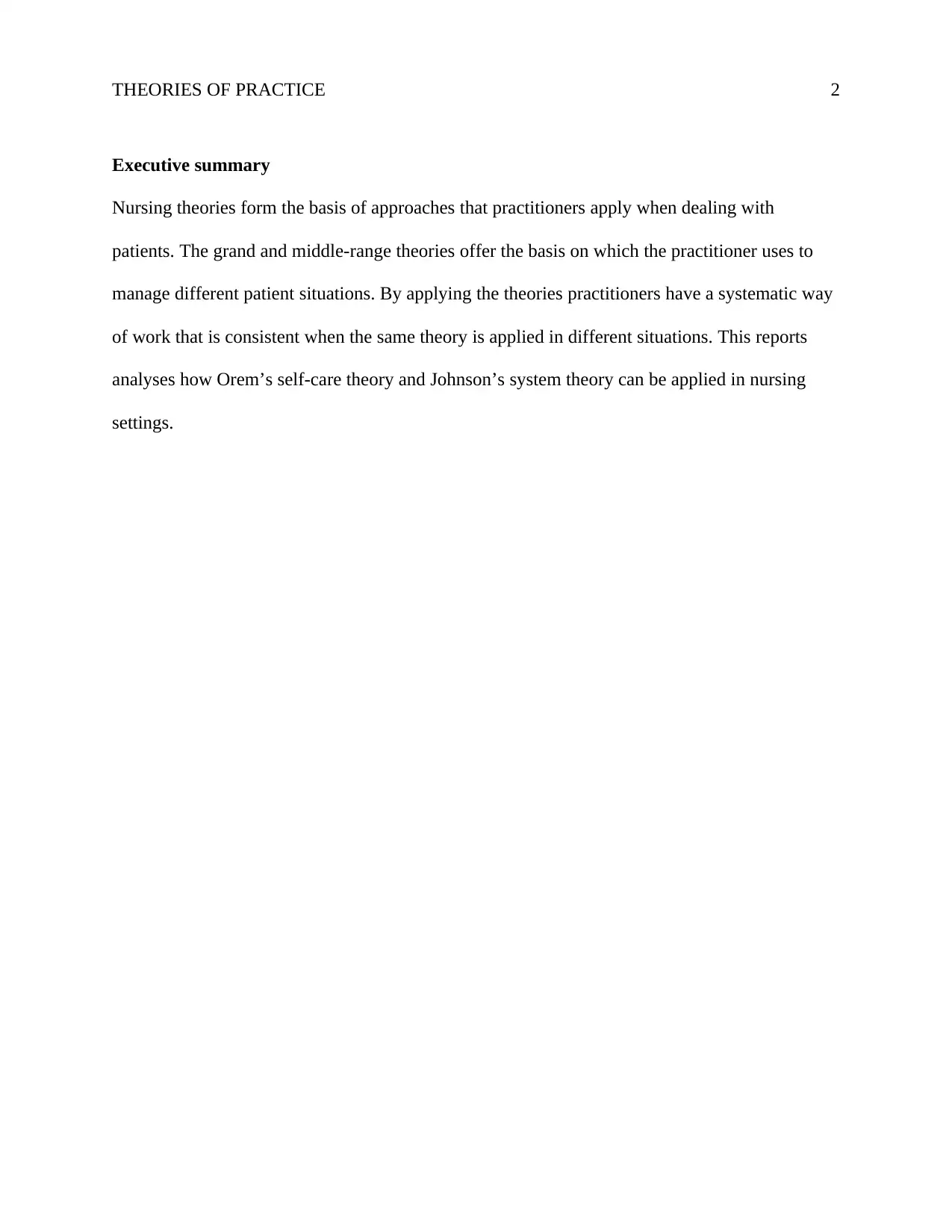
THEORIES OF PRACTICE 2
Executive summary
Nursing theories form the basis of approaches that practitioners apply when dealing with
patients. The grand and middle-range theories offer the basis on which the practitioner uses to
manage different patient situations. By applying the theories practitioners have a systematic way
of work that is consistent when the same theory is applied in different situations. This reports
analyses how Orem’s self-care theory and Johnson’s system theory can be applied in nursing
settings.
Executive summary
Nursing theories form the basis of approaches that practitioners apply when dealing with
patients. The grand and middle-range theories offer the basis on which the practitioner uses to
manage different patient situations. By applying the theories practitioners have a systematic way
of work that is consistent when the same theory is applied in different situations. This reports
analyses how Orem’s self-care theory and Johnson’s system theory can be applied in nursing
settings.

THEORIES OF PRACTICE 3
Table of Contents
Executive summary.........................................................................................................................2
Introduction......................................................................................................................................4
Orem’s Self-care grand theory.........................................................................................................4
Johnson’s Middle Range Systems Behavioral Theory....................................................................5
Conclusion.......................................................................................................................................7
References........................................................................................................................................8
Table of Contents
Executive summary.........................................................................................................................2
Introduction......................................................................................................................................4
Orem’s Self-care grand theory.........................................................................................................4
Johnson’s Middle Range Systems Behavioral Theory....................................................................5
Conclusion.......................................................................................................................................7
References........................................................................................................................................8
⊘ This is a preview!⊘
Do you want full access?
Subscribe today to unlock all pages.

Trusted by 1+ million students worldwide
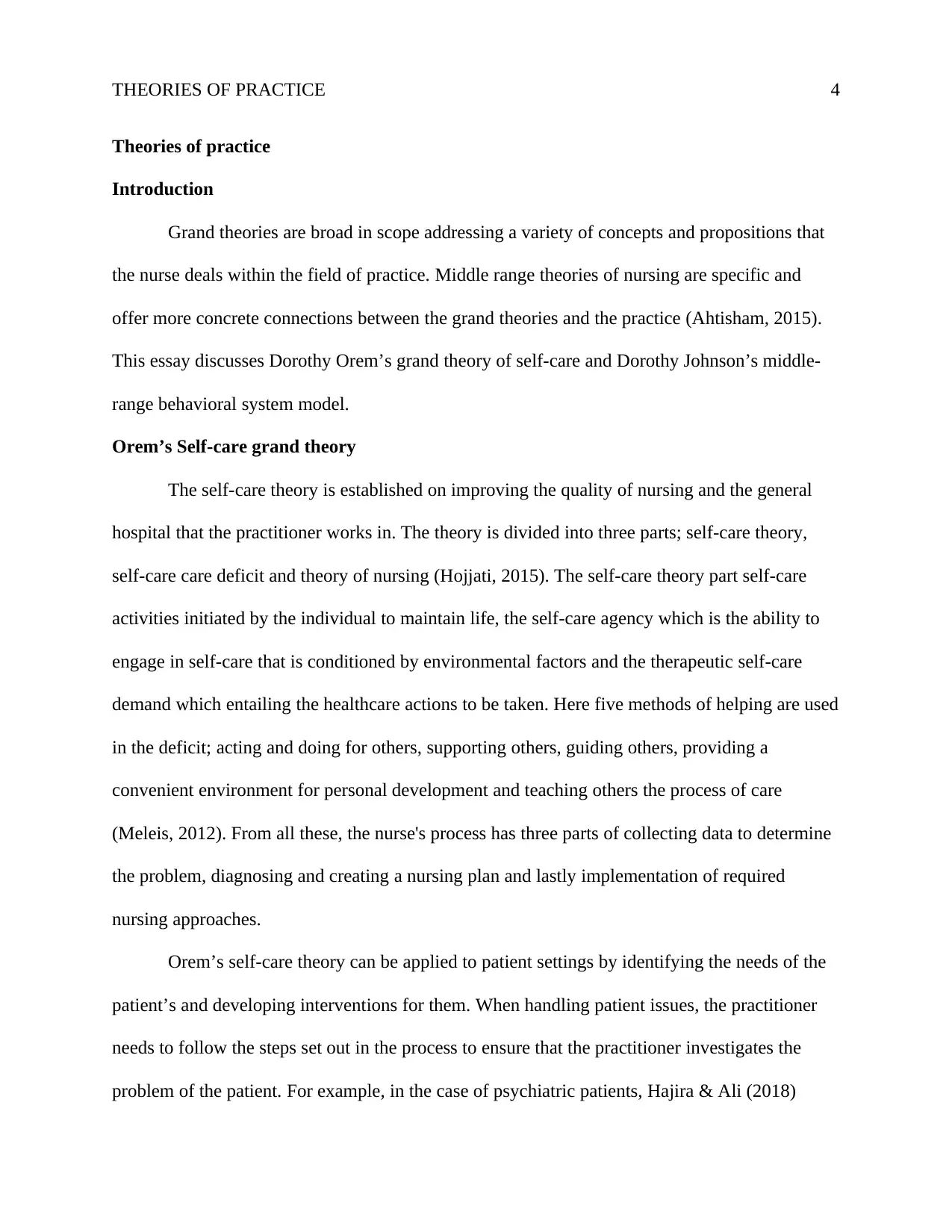
THEORIES OF PRACTICE 4
Theories of practice
Introduction
Grand theories are broad in scope addressing a variety of concepts and propositions that
the nurse deals within the field of practice. Middle range theories of nursing are specific and
offer more concrete connections between the grand theories and the practice (Ahtisham, 2015).
This essay discusses Dorothy Orem’s grand theory of self-care and Dorothy Johnson’s middle-
range behavioral system model.
Orem’s Self-care grand theory
The self-care theory is established on improving the quality of nursing and the general
hospital that the practitioner works in. The theory is divided into three parts; self-care theory,
self-care care deficit and theory of nursing (Hojjati, 2015). The self-care theory part self-care
activities initiated by the individual to maintain life, the self-care agency which is the ability to
engage in self-care that is conditioned by environmental factors and the therapeutic self-care
demand which entailing the healthcare actions to be taken. Here five methods of helping are used
in the deficit; acting and doing for others, supporting others, guiding others, providing a
convenient environment for personal development and teaching others the process of care
(Meleis, 2012). From all these, the nurse's process has three parts of collecting data to determine
the problem, diagnosing and creating a nursing plan and lastly implementation of required
nursing approaches.
Orem’s self-care theory can be applied to patient settings by identifying the needs of the
patient’s and developing interventions for them. When handling patient issues, the practitioner
needs to follow the steps set out in the process to ensure that the practitioner investigates the
problem of the patient. For example, in the case of psychiatric patients, Hajira & Ali (2018)
Theories of practice
Introduction
Grand theories are broad in scope addressing a variety of concepts and propositions that
the nurse deals within the field of practice. Middle range theories of nursing are specific and
offer more concrete connections between the grand theories and the practice (Ahtisham, 2015).
This essay discusses Dorothy Orem’s grand theory of self-care and Dorothy Johnson’s middle-
range behavioral system model.
Orem’s Self-care grand theory
The self-care theory is established on improving the quality of nursing and the general
hospital that the practitioner works in. The theory is divided into three parts; self-care theory,
self-care care deficit and theory of nursing (Hojjati, 2015). The self-care theory part self-care
activities initiated by the individual to maintain life, the self-care agency which is the ability to
engage in self-care that is conditioned by environmental factors and the therapeutic self-care
demand which entailing the healthcare actions to be taken. Here five methods of helping are used
in the deficit; acting and doing for others, supporting others, guiding others, providing a
convenient environment for personal development and teaching others the process of care
(Meleis, 2012). From all these, the nurse's process has three parts of collecting data to determine
the problem, diagnosing and creating a nursing plan and lastly implementation of required
nursing approaches.
Orem’s self-care theory can be applied to patient settings by identifying the needs of the
patient’s and developing interventions for them. When handling patient issues, the practitioner
needs to follow the steps set out in the process to ensure that the practitioner investigates the
problem of the patient. For example, in the case of psychiatric patients, Hajira & Ali (2018)
Paraphrase This Document
Need a fresh take? Get an instant paraphrase of this document with our AI Paraphraser
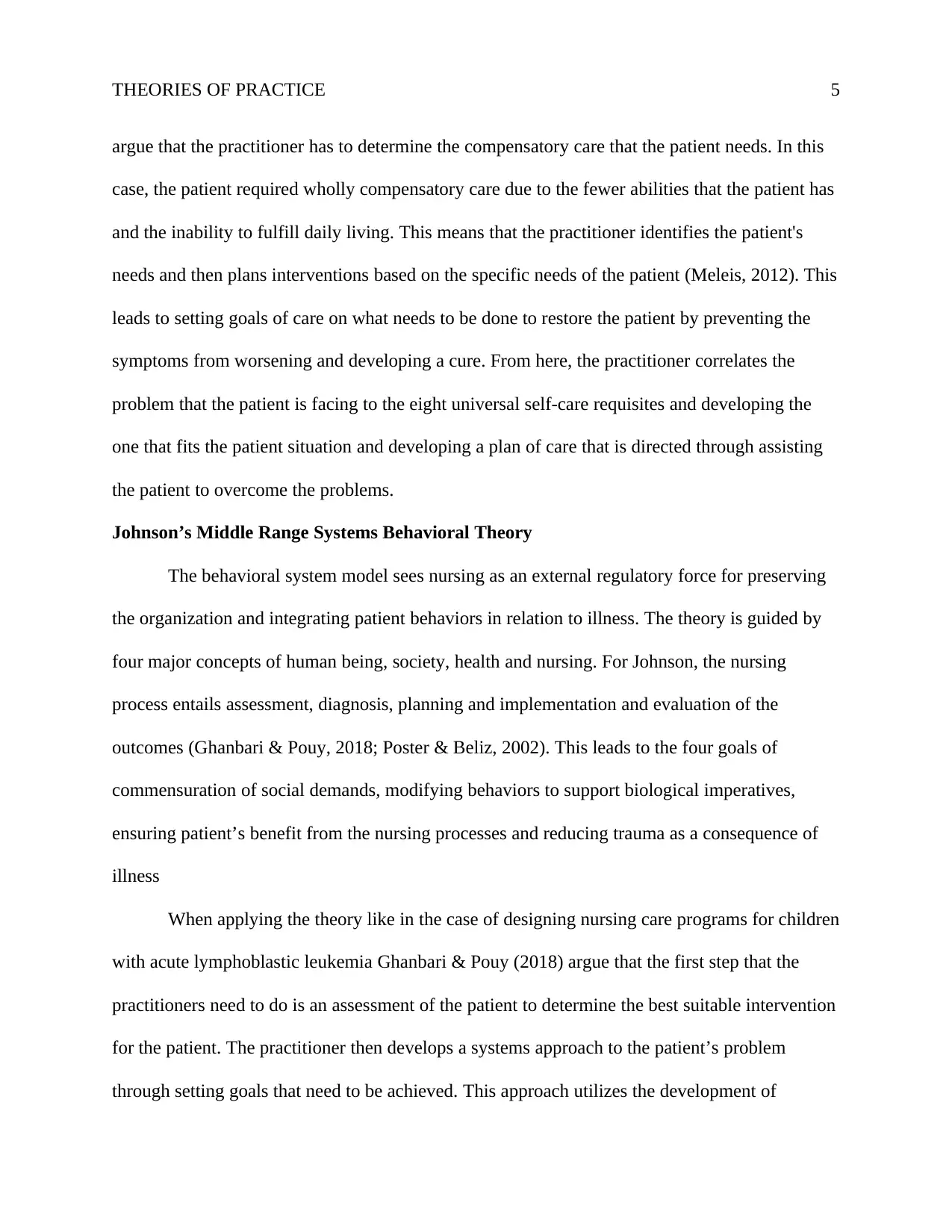
THEORIES OF PRACTICE 5
argue that the practitioner has to determine the compensatory care that the patient needs. In this
case, the patient required wholly compensatory care due to the fewer abilities that the patient has
and the inability to fulfill daily living. This means that the practitioner identifies the patient's
needs and then plans interventions based on the specific needs of the patient (Meleis, 2012). This
leads to setting goals of care on what needs to be done to restore the patient by preventing the
symptoms from worsening and developing a cure. From here, the practitioner correlates the
problem that the patient is facing to the eight universal self-care requisites and developing the
one that fits the patient situation and developing a plan of care that is directed through assisting
the patient to overcome the problems.
Johnson’s Middle Range Systems Behavioral Theory
The behavioral system model sees nursing as an external regulatory force for preserving
the organization and integrating patient behaviors in relation to illness. The theory is guided by
four major concepts of human being, society, health and nursing. For Johnson, the nursing
process entails assessment, diagnosis, planning and implementation and evaluation of the
outcomes (Ghanbari & Pouy, 2018; Poster & Beliz, 2002). This leads to the four goals of
commensuration of social demands, modifying behaviors to support biological imperatives,
ensuring patient’s benefit from the nursing processes and reducing trauma as a consequence of
illness
When applying the theory like in the case of designing nursing care programs for children
with acute lymphoblastic leukemia Ghanbari & Pouy (2018) argue that the first step that the
practitioners need to do is an assessment of the patient to determine the best suitable intervention
for the patient. The practitioner then develops a systems approach to the patient’s problem
through setting goals that need to be achieved. This approach utilizes the development of
argue that the practitioner has to determine the compensatory care that the patient needs. In this
case, the patient required wholly compensatory care due to the fewer abilities that the patient has
and the inability to fulfill daily living. This means that the practitioner identifies the patient's
needs and then plans interventions based on the specific needs of the patient (Meleis, 2012). This
leads to setting goals of care on what needs to be done to restore the patient by preventing the
symptoms from worsening and developing a cure. From here, the practitioner correlates the
problem that the patient is facing to the eight universal self-care requisites and developing the
one that fits the patient situation and developing a plan of care that is directed through assisting
the patient to overcome the problems.
Johnson’s Middle Range Systems Behavioral Theory
The behavioral system model sees nursing as an external regulatory force for preserving
the organization and integrating patient behaviors in relation to illness. The theory is guided by
four major concepts of human being, society, health and nursing. For Johnson, the nursing
process entails assessment, diagnosis, planning and implementation and evaluation of the
outcomes (Ghanbari & Pouy, 2018; Poster & Beliz, 2002). This leads to the four goals of
commensuration of social demands, modifying behaviors to support biological imperatives,
ensuring patient’s benefit from the nursing processes and reducing trauma as a consequence of
illness
When applying the theory like in the case of designing nursing care programs for children
with acute lymphoblastic leukemia Ghanbari & Pouy (2018) argue that the first step that the
practitioners need to do is an assessment of the patient to determine the best suitable intervention
for the patient. The practitioner then develops a systems approach to the patient’s problem
through setting goals that need to be achieved. This approach utilizes the development of

THEORIES OF PRACTICE 6
relationships between the practitioner and the patient and his/her to develop new behavioral
approaches. To restore the condition of the patient, the practitioner develops nursing
interventions that address the patient’s environment thus increasing the outcome of any
healthcare intervention on the patient. The practitioner developed measures for addressing the
problem through identifying insufficiency in protective and aggressiveness of the subsystem,
insufficiency in controlling the subsystem, insufficiency in the eliminative subsystem, the
discrepancy in restorative and achievement subsystem and insufficiency in achievement
subsystem.
These theories guide the way the nursing practitioner needs to approach the nursing
process. The behavioral model suggests the process that the practitioner needs to follow through
assessment, diagnosis, planning and implementation and evaluation. By viewing the nursing
environment as a system, the practitioner understands the different subsystems that they need to
work on to increase clinical outcomes (Schaffner, Tillett, & Volz, 2016). This means that the
nurse’s responsibility is to support and restore balance to the patient. The nurse needs to ensure
that an environment is created for the patient to open up on their problem. The nurse needs to
understand that behavioral efforts arise as a result of the patient’s ability to deal with the problem
that they are facing.
Conclusion
Therefore, the grand and middle-range theories of nursing offer propositions that nursing
practitioners need to follow in practice. The practitioner is supposed to follow a set of stages that
the selected theory defines the nursing process. This means that nursing practitioners can apply
different nursing principles depending on the one that suits the situation that they are in.
therefore each theory carries its own utility that the practitioner can apply.
relationships between the practitioner and the patient and his/her to develop new behavioral
approaches. To restore the condition of the patient, the practitioner develops nursing
interventions that address the patient’s environment thus increasing the outcome of any
healthcare intervention on the patient. The practitioner developed measures for addressing the
problem through identifying insufficiency in protective and aggressiveness of the subsystem,
insufficiency in controlling the subsystem, insufficiency in the eliminative subsystem, the
discrepancy in restorative and achievement subsystem and insufficiency in achievement
subsystem.
These theories guide the way the nursing practitioner needs to approach the nursing
process. The behavioral model suggests the process that the practitioner needs to follow through
assessment, diagnosis, planning and implementation and evaluation. By viewing the nursing
environment as a system, the practitioner understands the different subsystems that they need to
work on to increase clinical outcomes (Schaffner, Tillett, & Volz, 2016). This means that the
nurse’s responsibility is to support and restore balance to the patient. The nurse needs to ensure
that an environment is created for the patient to open up on their problem. The nurse needs to
understand that behavioral efforts arise as a result of the patient’s ability to deal with the problem
that they are facing.
Conclusion
Therefore, the grand and middle-range theories of nursing offer propositions that nursing
practitioners need to follow in practice. The practitioner is supposed to follow a set of stages that
the selected theory defines the nursing process. This means that nursing practitioners can apply
different nursing principles depending on the one that suits the situation that they are in.
therefore each theory carries its own utility that the practitioner can apply.
⊘ This is a preview!⊘
Do you want full access?
Subscribe today to unlock all pages.

Trusted by 1+ million students worldwide
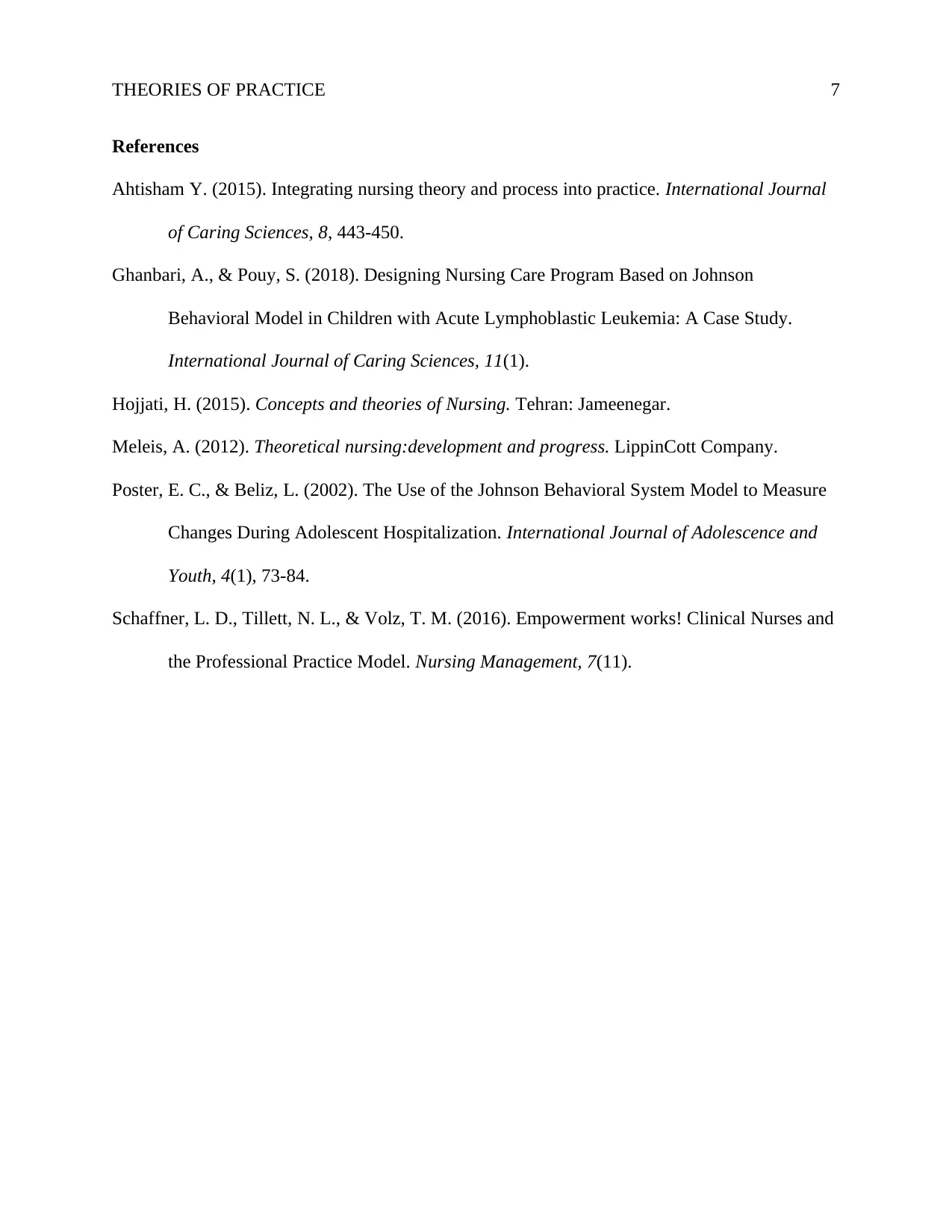
THEORIES OF PRACTICE 7
References
Ahtisham Y. (2015). Integrating nursing theory and process into practice. International Journal
of Caring Sciences, 8, 443-450.
Ghanbari, A., & Pouy, S. (2018). Designing Nursing Care Program Based on Johnson
Behavioral Model in Children with Acute Lymphoblastic Leukemia: A Case Study.
International Journal of Caring Sciences, 11(1).
Hojjati, H. (2015). Concepts and theories of Nursing. Tehran: Jameenegar.
Meleis, A. (2012). Theoretical nursing:development and progress. LippinCott Company.
Poster, E. C., & Beliz, L. (2002). The Use of the Johnson Behavioral System Model to Measure
Changes During Adolescent Hospitalization. International Journal of Adolescence and
Youth, 4(1), 73-84.
Schaffner, L. D., Tillett, N. L., & Volz, T. M. (2016). Empowerment works! Clinical Nurses and
the Professional Practice Model. Nursing Management, 7(11).
References
Ahtisham Y. (2015). Integrating nursing theory and process into practice. International Journal
of Caring Sciences, 8, 443-450.
Ghanbari, A., & Pouy, S. (2018). Designing Nursing Care Program Based on Johnson
Behavioral Model in Children with Acute Lymphoblastic Leukemia: A Case Study.
International Journal of Caring Sciences, 11(1).
Hojjati, H. (2015). Concepts and theories of Nursing. Tehran: Jameenegar.
Meleis, A. (2012). Theoretical nursing:development and progress. LippinCott Company.
Poster, E. C., & Beliz, L. (2002). The Use of the Johnson Behavioral System Model to Measure
Changes During Adolescent Hospitalization. International Journal of Adolescence and
Youth, 4(1), 73-84.
Schaffner, L. D., Tillett, N. L., & Volz, T. M. (2016). Empowerment works! Clinical Nurses and
the Professional Practice Model. Nursing Management, 7(11).
1 out of 7
Related Documents
Your All-in-One AI-Powered Toolkit for Academic Success.
+13062052269
info@desklib.com
Available 24*7 on WhatsApp / Email
![[object Object]](/_next/static/media/star-bottom.7253800d.svg)
Unlock your academic potential
Copyright © 2020–2025 A2Z Services. All Rights Reserved. Developed and managed by ZUCOL.





